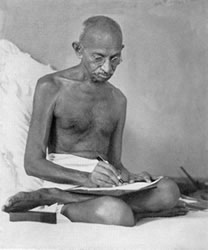
P.O. SEVAGRAM, DIST.WARDHA 442102, MS, INDIA. Phone: 91-7152-284753
FOUNDED BY MAHATMA GANDHI IN 1936
Short Stories For Everyone
Inspiring incidents from Gandhiji's Life: Selected from the book Everyone's Gandhi
(For the children in the age group of 10 to 15 years)

SHORT STORIES FOR EVERYONE
Gandhi's inspiring short stories selected from the book Everyone's Gandhi
Editor by : Rita Roy
Table of Contents
- All for A Stone
- A Car And A Pair of Binoculars
- My Master's Master
- Enter The Monkeys
- Premchand Quits His Job
- Returning His Medals
- Basic Pen
- Prisoner No. 1739
- Gandhi's White Brother
- Who Saw Gandhi?
- An Early School
- An Unusual March
- Spiritual Heir
- The Less You Have The More You Are
- An Old Goat Talks
- The Phoenix Settlement
- Gandhi in Amsterdam
- Something To Be Shy About?
- Gandhiji The Matchmaker
- Gandhi's Army
- Dandi Snippet
- Hiding Something
- The Image Maker
- Creative Reader
- Postcards To The Rescue
- A Non-violent Satyagraha 214 Years Ago
- Gandhi And Delhi
- Gandhiji's Constructive Programme
- Gandhi Looks At Leprosy
- Baba Amte
- They Gave Peace A Chance
- From Mahatma To God
- Customs Are Out of Fashion
- The Man 'Charlie' Wanted To Meet
- It Came Naturally To Him
- Crossing The Sea of Narrow-Mindedness
- Wear Clothes As They Should Be Worn
- Education: For Life, Through Life
- The Abode of Joy
- To Cling to A Belief
- The Fruit of A Child's Labour
- An Ideal Prisoner
- How A Film Became Something More
- Gandhi: Beyond India
- Gandhi's Life-Saving Medicine
- Understanding The Mechanics of Life With Gandhi
- The Lokmanya and The Mahatma
- Man's Gift To Nature
- Gurudev And His Mahatma
- One-man Boundary Force
- What Does Mahatma Gandhi's Message Mean To Me?
- Let's Play Together
- Children's Response To Conflict
- Beggar By Choice
- The Better Half
- Uncle Gandhi
- The Watch: An Instrument For Regulating Life
- Light The Lamp of Your Mind
- Gandhi's Bet!
- Gandhi Feeling At Home In The Kitchen
- What Is Simplicity?
- Bapu And The Sardar
- The Power of Quality
- Gandhi: The Teenager!
Chapter 9: Gandhi's White Brother
K.S. Naryanaswamy
In the vegetarian restaurant where he took his food, Kallenbach would often see a young barrister. This was an Indian lawyer who dressed like an Englishman and had taken up the cause of Indian labourers in South Africa. It was not long before the German engineer and M. K. Gandhi became friends.
They had a great deal in common a deep attraction for simple life and working for the good of their fellow beings. At the time Gandhi was struggling for the rights of Indians and Africans in a land dominated by white men.
The form of resistance that Gandhiji used was unique: satyagraha. He would patiently appeal to the good sense of the whites while also refusing to follow their laws that he regarded evil. He was willing to suffer punishment for breaking these laws but refused to hate the white men.
Kallenbach was attracted by this method. He and Gandhiji worked together for the poorest of the poor. They changed their own life style and honoured every useful work. They said that a lawyer or an engineer was not superior to a cobbler or a scavenger. In fact they went to a Chinese cobbler in Johannesburg and learnt to make footwear. And they undertook to clean their own latrines, something most people would not do in these days.
From Ruskin's book Unto This Last, Kallenbach and Gandhi laid down three principles for themselves: (i) the good of the individual is in the good of all; (ii) all work is noble and all are equal; and (iii) a life of labour is worth living.
In 1903 Gandhi's family came over to South Africa. Though Kallenbach became a dear uncle to his three children, Gandhi would not let him buy costly toys for them. They must not feel that they are different from poor people, he would say.
In 1910 Kallenbach, who was a rich man, donated to Gandhi a thousand acre farm belonging to him near Johannesburg. This was a very great gift indeed and was used to run Gandhi's famous 'Tolstoy Farm' that housed the families of satyagrahis.
With the satyagraha campaign in full swing, Gandhi would often go to prison. During such times, Kallenbach would take up the work of editing Indian Opinion, a weekly paper started by Gandhi. Being white, he could not be punished under the South African laws. This angered the white rulers no end, but Kallenbach carried on as a co-worker with Gandhi.
When Gandhi started the Phoenix Ashram near Durban, living as a farmer and labourer, Kallenbach gladly joined in this new life. He built the simple sheds for the inmates, working as a mason and carpenter.
In 1915 Gandhi returned to India. The First World War had broken out. England and Germany were at war with each other. Being a German, Kallenbach was refused entry into India and had to return sadly to South Africa, where he continued his work as a satyagrahi.
Kallenbach did come to India in 1936, when he visited Gandhi's ashram at Sevagram near Wardha. He was ill at that time. Gandhi nursed him back to health himself.
In 1937 the Second World War broke out, Kallenbach was again put into jail by the South African Government.
When Kallenbach died of illness a little after this, in 1938, Gandhiji felt he had indeed lost a brother.